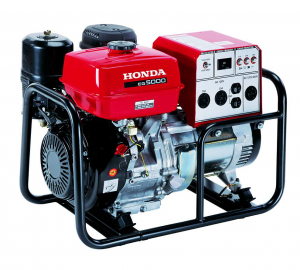Introduction
Engine Driven Generator is popular equipment set with rather wide range of capacity, design and use. It burns fuel either liquid or gas in internal combustion chamber to make mechanical dynamic energy, drive alternator to generate electricity.
Gasoline engine generator is light weight, but higher fuel cost, used majorly for movable usage.
Gas engine generator is used where supply of natural fuel gas is available. Only gas with majority of composition is methane can be used for gas engine. Because methane content results high octane number which is good for engine co-efficiency. However, gas turbine is replacing gas engine for generator as gas turbine required longer interval to shutdown for maintenance.
Diesel engine is most popular used as its economic to generate a kWh. Most of diesel engine generators have rated speed of 1500rpm or 1800rpm, will use high speed diesel oil, not heavy diesel oil which is used for marine engine.
In some place where fuel gas is available and cheap, a part of fuel gas is fed within control to air intake of diesel engine and combusted in combustion chamber together with diesel oil injected to. This configuration is call dual fuel system.
Operations of Engine Driven Generator is majorly dealing with matters of
- Continuity of fuel supply
- Quality of fuel
- Planned preventive maintenance (PPM)
- Managing load
Pictures of Engine Driven Generators:

Movable gasoline engine generator |
 Portable diesel engine generator Portable diesel engine generator |

Diesel engine generator |
|
A generator set comprises: Engine body, Fuel condition system, Engine radiator & exhaust, Alternator, Coupling, Output CB/MCB, Automation control system (speed, voltage, protection …), Sound proof, environment shield
Some operational requirement you may have in your application:
- High reliability
- Usually start up / shutdown
Guide to use type of generators according to their capacity:
| Hình – (cập nhật sau)
|
Relevant technical standards:
BS-123: xxx
TCVN – 1234 xxx
EIC – 1234xx
Keyword definition
Canopy / Coupling / Frequency /Hazardous area / Rated power / Radiator / Noise / Sound proof
Cost estimation for planning (optional)
(not available share)
How to prepare a bid
Suggested reading
SOW
Description of application, datasheet of driver and alternator, requirements for package.
Need to specify brand, country of origin if required.
>>Download engine driven generator data sheet
Technical criteria
- Meet technical requirement as per specification as per datasheet and operational requirement.
- General T&C compliance
- Delivery
Bid price
If you take consumables, spare parts, maintenance into LCC, you must use reliable source of reference, do not use source of reference subjectively.
Otherwise just use cost of purchasing for bid commercial evaluation.
Traps and tips in procurement
Typical traps
- Insufficient capacity.
You request a generator for continuous consumption of 125KVA at 50Hz. But trader propose a generator 125KVA at 60Hz for operation mode is emergency.
Why? Take cosj 0.85, correction to 50Hz, and 25% rated for continuous operation. So required capacity is up to 125*60/50*1.25/0.85 =220KVA. If you accept this, mean you met get 50 – 60% required capacity.
- Critical parameter is not specific
You need a low noise generator skid at noise level lower 70dB. Trader propose a skid without enclose and quote that noise at 7m is below 70dB. Specify noise level at what distance 1m, 3m, 7m?
- Fuel quality may impact seriously engine performance. Determine if fuel conditioning system is required.
Lesson learnt
(not available sharing)
Tips:
Use datasheet to specify as much as possible what you need. Below are essentials
- Frequency in Hz and stability requirement
- Rated capacity in KVA
- Power needed to cover present and future necessities.
- Continuous/emergency?
- Kind of load. Some kind of load like centrifugal pump require high rush current; hence, you need to determine allowable overload.
- Legal regulations and local laws (electric, noise, pollution). Specify noise level at what distance: 1m, 3m, 7m?
- Ingress protection level. Fit for working environment: dusty, rain water?
- Standard for exhaust system and electricity system, control system is up how hazardous location is: no hazardous, hazardous Zone 1, Zone 2 (intermittent hydrocarbon release) …
- Total weight? It impact shipping and installation
- Reliability? Select appropriate brand.
- The operational requirements to be incorporated in the equipment: manual or automatic start, redundancy with other units or with the mains, soundproofing, auxiliary fuel tanks, heating system etc
- Others
Article general information
Author: BENA
Disclaimer: This article tells you overall and essential of the topic, but not all. Your application may be special as location, fuel supply … and you know it better anyone else. You can get your in-house trained personnel to elaborate requirement or to get consultant to define requirement for your procurement. Our sharing do not form basic for any claim.
